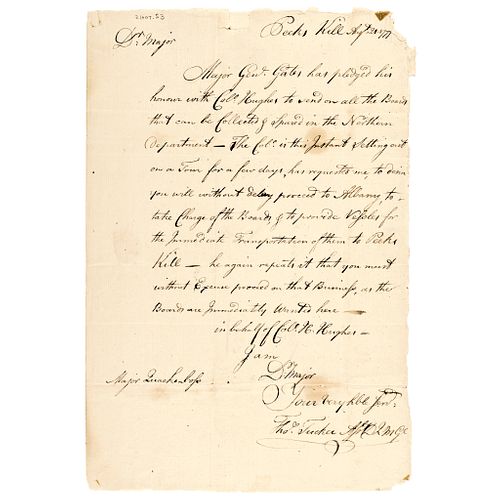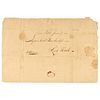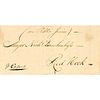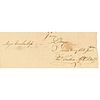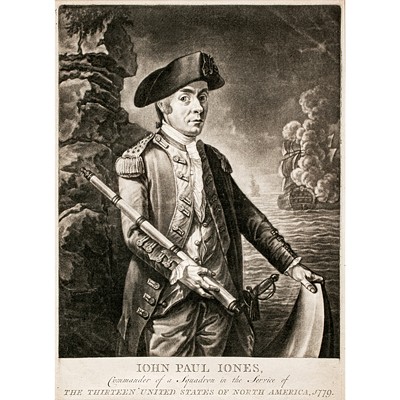1777 Revolutionary War Urgent Request for Wood Boards
Lot 86
Categories
Estimate:
$800 - $1,000
Absentee vs Live bid
Two ways to bid:
- Leave a max absentee bid and the platform will bid on your behalf up to your maximum bid during the live auction.
- Bid live during the auction and your bids will be submitted real-time to the auctioneer.
Bid Increments
| Price | Bid Increment |
|---|---|
| $0 | $10 |
| $200 | $20 |
| $300 | $25 |
| $500 | $50 |
| $1,000 | $100 |
| $2,000 | $200 |
| $3,000 | $250 |
| $5,000 | $500 |
| $10,000 | $1,000 |
| $20,000 | $2,000 |
| $30,000 | $2,500 |
| $50,000 | $5,000 |
| $100,000 | $10,000 |
| $200,000 | $20,000 |
| $300,000 | $25,000 |
| $500,000 | $50,000 |
About Auction
By Early American History Auctions
Jan 23, 2021
Set Reminder
2021-01-23 12:00:00
2021-01-23 12:00:00
America/New_York
Bidsquare
Bidsquare : Early American History Auction of Autographs, Americana, Political & Maps
https://www.bidsquare.com/auctions/early-american-history-auctions/early-american-history-auction-of-autographs-americana-political-maps-6311
311 Lots of Rare, Historic Autographs, Americana, Civil War Era, George Washington, Abraham Lincoln, Slavery & Black History, Revolutionary War Era, Colonial America, Federal Period, War of 1812, Colonial Currency, Indian Peace Medals & more... Early American History Auctions auctions@earlyamerican.com
311 Lots of Rare, Historic Autographs, Americana, Civil War Era, George Washington, Abraham Lincoln, Slavery & Black History, Revolutionary War Era, Colonial America, Federal Period, War of 1812, Colonial Currency, Indian Peace Medals & more... Early American History Auctions auctions@earlyamerican.com
- Lot Description
American Revolution
1777 Battle of Saratoga Revolutionary War Urgent Request for Wood Boards for the Continental Army
August 21, 1777-Dated Revolutionary War Period, Autograph Letter Signed, "Tho(mas) Tucker," as Assistant Deputy Quartermaster General, Requesting Wood Boards be Sent to Peekskill (New York), Choice Very Fine.
This is an historic, original 1 page, 12.25" x 8" Revolutionary War Autograph Letter Signed by Thomas Tucker, as Assistant Deputy Quartermaster General, being written to Major Nicholas Quakenbush, Continental Army Deputy Quartermaster. Creases, some light chipping to margins, a few toned spots. Integral Address Leaf Envelope attached, being headed: "(on Public Service) - Major Nichl. Quackenbush -- Red Hook (via) Express." Original red wax envelope seal remains intact, boldly written in rich brown and easily readable upon clean period laid paper. Fully intact and pleasing, mailing folds and minor scattered tone. This letter requesting urgently needed and crucial supplies of boards, likely for the trenches and defenses built by the Continental Army prior to the Battle of Saratoga. It reads, in full;
"Peeks Kill - Aug(ust) 21, 1777 --- Major Genl. Gates has pledged his honour with Col Hughes to send on all the Boards that can be Collected & Spared in the Northern Department - The Col is this Instant Setting out on a Tour for a few days, has requested to me, to desire you will without delay proceed to Albany to take Charge of the Boards, & to provide Vessel for the Immediate Transportation of them to Peeks Kill - he again repeats it that you must without Excuse proceed on that Business, as the Boards are immediately Wanted here - in behalf of Col. H. Hughes -- I am D(ear) Major -- Your Very h(um)ble Servt. - Thos. Tucker, Ast D Q M Gl."
A letter requesting that wood boards be sent to Peekskill. Burgoyne's army had passed Fort Edward and seemed in easy reach of Albany. Still, the Americans expected a British advance northward to join Burgoyne. But because of Howe's decision to take Philadelphia, the northern push never really came to fruition. In early October, British General Henry Clinton led an expedition in an effort to relieve Burgoyne who was then hemmed in at Saratoga. They captured Forts Montgomery and Clinton and burned Kingston but wisely chose not to fight his way to Albany.
The Battles of Saratoga (September 19 and October 7, 1777) conclusively decided the fate of British General John Burgoyne's army in the American War of Independence and are generally regarded as a turning point in the war. The battles were fought eighteen days apart on the same ground, 9 miles (14 km) south of Saratoga, New York.
Burgoyne's campaign to divide New England from the southern colonies had started well, but slowed due to logistical problems. He won a small tactical victory over General Horatio Gates and the Continental Army in the September 19 Battle of Freeman's Farm at the cost of significant casualties. His gains were erased when he again attacked the Americans in the October 7 Battle of Bemis Heights and the Americans captured a portion of the British defenses. Burgoyne was therefore compelled to retreat, and his army was surrounded by the much larger American force at Saratoga, forcing him to surrender on October 17. News of Burgoyne's surrender was instrumental in formally bringing France into the war as an American ally, although it had previously given supplies, ammunition and guns, notably the de Valliere cannon, which played an important role in Saratoga. Formal participation by France changed the war to a global conflict. This battle also resulted in Spain contributing to the war on the American side.
The first battle, on September 19, began when Burgoyne moved some of his troops in an attempt to flank the entrenched American position on Bemis Heights. Benedict Arnold, anticipating the maneuver, placed significant forces in his way. While Burgoyne succeeded in gaining control of Freeman's Farm, it came at the cost of significant casualties. Skirmishing continued in the days following the battle, while Burgoyne waited in the hope that reinforcements would arrive from New York City. Militia forces continued to arrive, swelling the size of the American army. Disputes within the American camp led Gates to strip Arnold of his command.
Concurrently with the first battle, American troops also attacked British positions in the area of Fort Ticonderoga, and bombarded the fort for a few days before withdrawing. British General Sir Henry Clinton, in an attempt to divert American attention from Burgoyne, captured American forts in the Hudson River highlands on October 6, but his efforts were too late to help Burgoyne. Burgoyne attacked Bemis Heights again on October 7 after it became apparent he would not receive relieving aid in time. In heavy fighting, marked by Arnold's spirited rallying of the American troops (in open defiance of orders to stay off the battlefield), Burgoyne's forces were thrown back to the positions they held before the September 19 battle and the Americans captured a portion of the entrenched British defenses.
Nicholas Quackenbush (1734-1813) was a member of a powerful Dutch family in the Hudson River Valley. He sided with the Revolutionary cause, serving as Assistant Deputy Quartermaster to the Continental forces in Albany with rank as Major. In this capacity, Quackenbush, situated roughly half way between Albany and Montreal, was one of the most important people in the region, coordinating critical supplies that would ultimately result in the defeat of Burgoyne at Saratoga in 1777 and help secure the Mohawk valley frontier against Loyalist and Indian raids. The letters are primarily from others in the quartermaster corps concerning critical supplies for the campaign of 1777.
- Shipping Info
-
Early American provides in-house worldwide shipping. Please contact us directly if you have questions about your specific shipping requirements.
-
- Buyer's Premium



 EUR
EUR CAD
CAD AUD
AUD GBP
GBP MXN
MXN HKD
HKD CNY
CNY MYR
MYR SEK
SEK SGD
SGD CHF
CHF THB
THB